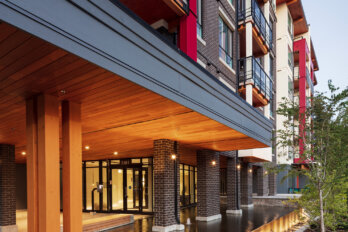A SPECIAL CANADA MORTGAGE AND HOUSING CORPORATION SUPPLEMENT
Watching COVID-19 devastate New York City, the most densely populated metropolitan centre in North America, made it easy to imagine that urban density is a problem. The soaring infection and mortality rates of early 2020 gave Canada’s urban residents reason to consider a switch to country life — or at least more space in the suburbs.
But with COVID-19 cases popping up everywhere, from metropolises to small towns, experts are reassuring city dwellers that they can safely stay put rather than create more sprawl. In fact, public health researchers from Johns Hopkins University have found that people living in denser communities are not experiencing higher infection rates than their spread out counterparts. Canada Mortgage and Housing Corporation (CMHC) is also increasingly recognizing that intensification, or creating denser communities, can play a positive role in addressing not only housing affordability but other challenges — such as access to services, health status, and climate change — that factor into where people choose to live. Here’s how.
ACCESS TO SERVICES
🚗Commuting
What does it really cost us?
Commuting may have changed during the pandemic, but certain habits remain the same. According to Statistics Canada, 84 percent of commuters who used personal motor vehicles before the pandemic were still using that mode of transportation to go to work in June. Here’s what commuting looks like across the country.
Average car commute times for people living in urban centres*:
Toronto:
28.7
minutes
Vancouver:
25.7
minutes
Montreal:
25.6
minutes
The strong social connections forged in walkable communities can also act as a safety net in times of crisis. They create the conditions that allow community members to come together and ensure their most vulnerable have resources, as many have done during the COVID-19 lockdown. Mennill further underscores that accessible community services and social supports — which can be limited in smaller, more sprawling cities — are vital to the health and well-being of vulnerable communities and low- and moderate-income families. And ensuring that these communities can get to and use them is less challenging when they’re not far-flung. “Community services are much more available and easier to pro-vide in a denser setting,” he says.
HEALTH OUTCOMES
Number of commuters driving an hour or more each way*:
Toronto/GTA:
642,934
Vancouver Metro:
54,460
Montreal/GMA:
183,301
Studies in the United States suggest urban density between 360 and 1,540 people per square kilometre leads to more walking. (In 2016, thirty-two Canadian urban areas had at least 360 people per square kilometre, and one had at least 1,160 people per square kilometre.)
19.9%
Canada’s total greenhouse gas emissions per year that come from personal-use cars and commercial-use cars and trucks
HOUSING AFFORDABILITY
Canadians who report having “very stressful days”***
23%
of people commuting 15 minutes or less
36%
of people commuting 45 minutes or more
*Source: Statistics Canada “Results from the 2016 Census: Long commutes to work by car”
**Source: Prairie Climate Centre, “Where Do Canada’s Greenhouse Gas Emissions Come From?”
***Source: Statistic Canada. 2010 General Social Survey
ENVIRONMENTAL SUSTAINABILITY
When it comes to daily life’s carbon emissions, living in low-density suburbs can mean driving everywhere. “When you force everyone into cars for everything, you force them into high-carbon lifestyles whether they like it or not,” says Mennill. He adds that there are also carbon costs associated with the municipal services necessary to keep up with suburban sprawl: road maintenance, snow removal, garbage pickup, fire protection, policing, and schools. Low-density housing also requires more road infrastructure and generally has less efficient energy use than in multi-unit homes.
Mennill stresses, however, that no housing benefit should be thought of in isolation. “Good housing is not just affordable, or just healthy, or just climate-friendly, or just socially inclusive. It has to be all those things,” he says. “We should see good housing as a package, and density is one of the key ingredients to achieving all of these things simultaneously.”




